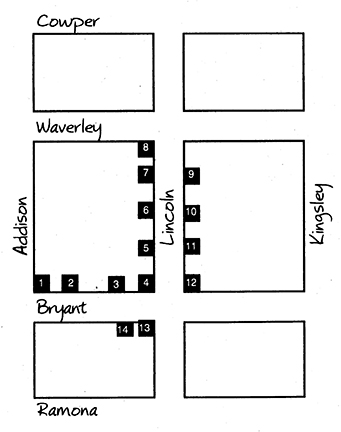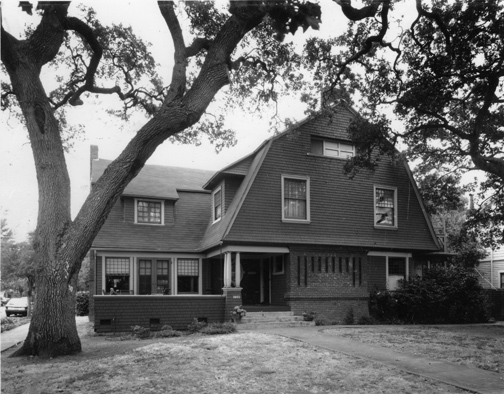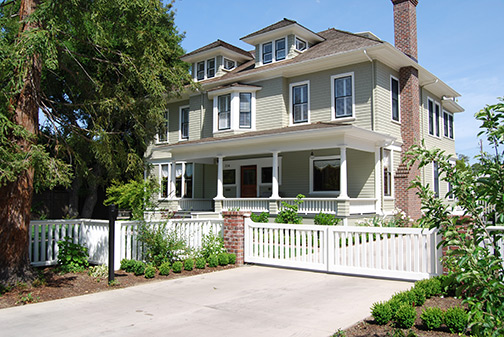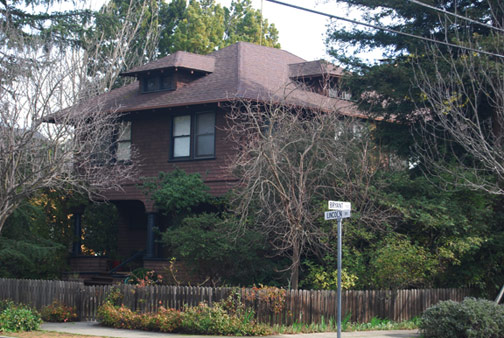 Palo Alto Stanford Heritage
Palo Alto Stanford Heritage | History | Styles | Map | Houses |
Professorville History
In the early 1890s, Stanford faculty settled a residential area that came to be known as Professorville. It was near downtown and allowed for easy access to the university via Embarcadero Road. The area also attracted faculty families because Stanford land could only be leased, not purchased.
The area is listed on the National Register as an Historic District.
Ward Windslow remembers Professorville.
Professorville Styles
There are primarily three styles of architecture in Professorville: Shingle, Colonial Revival and Craftsman. The Shingle style emerged around the same time as Professorville. A distinct feature of a Shingle style house is that it is designed from the inside out—so the doors and windows are placed wherever needed or desired. The walls and roof of this style enclose the interior space with a continuous skin. Colonial elements such as gambrel roofs, classical columns and Palladian windows are often incorporated.
In contrast to a Shingle style house, a Colonial Revival house is designed from the outside in. It is symmetrical and often has a centered, accentuated front door and multi–pane double hung windows. The resulting appearance is formal and balanced.
The third style seen in Professorville is the Craftsman. It embraces the Shingle movement by emphasizing the use of natural materials. A distinctly Craftsman characteristic is that the decorative features express a structural purpose. Bracketed wide eaves and exposed rafter tails are common.

Printable brochure with descriptions, but no images.
Professorville Houses
1. 1005 Bryant, Angell House —1893

This house is a fine example of the eastern Shingle style. It is unified by its gambrel roofs and shingle surfaces. Note the unusual brick work in the facade of the fireplace and chimney. The house was built for Professor Frank Angell, a member of the original Stanford faculty. Angell was head of the psychology department, but he was best known as the first track coach and "father" of Stanford athletics. Angell Field, the university's original track and field oval, is dedicated to him.
2. 1017 Bryant, Murray House — 1893
Colonial elements dominate this house despite the fact that it is sheathed in shingles. The broad facade is capped by a gambrel roof with balanced dormers. Two of the dormers have matching gambrel roofs and all have diamond–pane windows. The first Friends Meeting Place in Palo Alto was located here in the home of Professor Augustus Taber Murray, a classical scholar on Stanford's first faculty.
3. 1033 Bryant — 1899
This Shingle style house with its gambrel roof has prominent pilasters flanking the asymmetrically placed square bay. It was the home of Professor James Perrin Smith, a Stanford geologist, and Frances Norris Rand Smith, an authority and writer on California missions.
4. 1061 Bryant — 1899
Long called the "Sunbonnet House" because of its gambrel–roofed entry, this house is the second one built on this site. Distinguished Bay Area architect Bernard Maybeck designed both houses for Emma Kellogg. The first one, described as the "oddest, neatest, tastiest house in Palo Alto," burned down and was immediately replaced by the Sunbonnet House. A recent major restoration restored the original sunbonnet design and facade configuration.
5. 331 Lincoln, Thoburn House — 1893
This subdued Victorian style house features fish–scale shingles and stained glass in the attic gable. It was built for Professor Thoburn, an ordained Methodist minister and a Stanford professor of bionomics, an early form of ecology. A cottage for Mr. Thoburn's mother was constructed at the rear of the property in 1899.
Shortly thereafter, the cottage was moved next door to its present location at 329 Lincoln.
(No inventory sheet)
6. 345 Lincoln, Wing House — 1893
Several architectural styles display themselves in an exuberant combination in this house. The window proportions and their slanted bays and incising are Victorian elements. The pediment and pilasters of the roof gable are Greek in origin. The gambrel roof is Colonial. Stanford Art Department Chairman Arthur B. Clark designed the house for his colleague, civil engineering professor Charles B. Wing. At the rear of the house is a now–attached tank house that covered a well system operated by the Wing, Charles Marx, Angell, Murray and Thoburn families. Professor Wing encouraged the incorporation of Palo Alto in order that a city water system could be created; he then helped to found the city's utility systems. His other accomplishments include designing the uniquely constructed Stanford Stadium and being a founder of Big Basin State Park. This house was recently restored to allow it to endure for another century.
7. 365 Lincoln — 1903
This handsome house exemplifies the Craftsman style. Note the porch and roof bracketing. Other distinctive elements include the asymmetrical fenestration featuring a second floor bow window set off by curved railings, as well as the commodious veranda. Gus Laumeister built this house for mathematics and engineering professor Leander M. Hoskin.
8. 381 Lincoln — 1894
Displaying a restrained design, this house combines the Shingle and Colonial Revival styles. It was built for N. H. Kilgore, a city recorder and Methodist Church trustee.
Inventory sheet
9. 356 Lincoln — 1896
This elegant Craftsman bungalow with its gabled porch and generous eaves, has an unusual pavilion massing and an overall oriental feeling. Professor Arthur B. Clark designed the house for Guido Marx, a member of Stanford's engineering department. Marx and his wife, a long–time trustee of the Palo Alto Library, were active in community cultural and educational affairs.
10. 334 Lincoln — 1897

Reflecting Colonial Revival symmetry in its second and attic stories, this large, gracious house was built for the Reverend William P. Hyde. When his son, William F. Hyde, was asked by the Stanfords to establish and operate the campus bookstore, the family decided to build in Palo Alto so the other seven children could avail themselves of the university.
11. 318 Lincoln — 1901
The double–gable dormer with its sawtooth edge distinguishes this Shingle style house. It originally belonged to Nathan Abbott, first dean of the Stanford Law School. Harvard guest lecturer, William James, the father of American psychology, was a house guest when the 1906 earthquake struck. He refused to leave his room because he was recording his reactions.
12. 308 Lincoln — 1902

Gus Laumeister built this shingle house for Mrs. Corabelle Kimball. The first occupant was Edwin Duryea, a young engineer from Cornell helped the city develop its water supply system and later became prominent in city government.
13. 1052 Bryant — 1900
This Craftsman bungalow was the first home of J. W. Osborne, an inventor of a photolithography process. From 1908 to 1924 it was occupied by H.W. Simkins, who co–authored the city charter and devised the street numbering system. He owned and edited the Palo Alto Times from 1902 to 1919.
14. 1044 Bryant, Varian House — 1902
This cottage belonging to the John O. Varian family was one of the liveliest intellectual centers of Professorville in early times. Varian's theosophical and literary pursuits made the parlor an informal school. Varian's sons, Russell and Sigurd, were inspired by their father's love of nature and founded Castle Rock Park near Big Basin. Their great achievement was the invention (with William W. Hansen) of the klystron tube, a key to World War II radar and a major foundation of post–war electronics.
| |

|
E-mail us at either webmaster@pastheritage.org or president@pastheritage.org.
![]() Palo Alto Stanford Heritage—Dedicated to the preservation of Palo Alto's historic buildings.
Palo Alto Stanford Heritage—Dedicated to the preservation of Palo Alto's historic buildings.
Copyright © 2016 Palo Alto Stanford Heritage. All rights reserved.